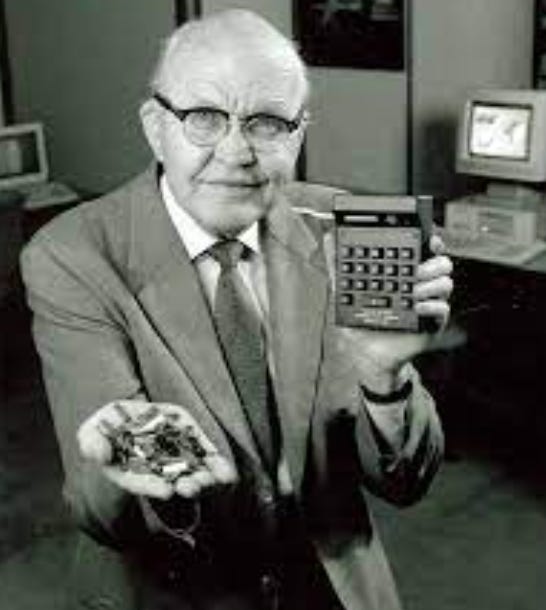“Time with You” by Gary Soto from Partly Cloudy. © Harcourt, 2009.
ORIGINAL TEXT AND AUDIO - 2017
On this date in 1952, Geoffrey W.A. Dummer first presented the concept of the integrated circuit, also known as the microchip, which is the basis for all modern electronic equipment.
Geoffrey Dummer was born in Yorkshire in 1909 and studied electrical engineering at Regent Polytechnic in London. He held a series of jobs in the 1930s, including a post with the Ministry of Defence; his group was responsible for the first radar screen ever built. During World War II, he trained American and Canadian forces in ground-based aircraft detection training. Throughout his career, he was always looking for a way to make electronic components more reliable.
The integrated circuit is an advanced form of the electrical circuit, which is made up of a set of components — a transistor, a resistor, a capacitor, and a diode — linked together in a variety of ways. The transistor, which controls the electrical power — turning it on and off — was a big advance over the vacuum tubes used in the first computers. Vacuum tubes are like light bulbs: they generate a lot of heat, and they eventually burn out. They're also much bigger than their successors, the transistors. Early computers powered by hundreds of vacuum tubes were unreliable and required a lot of room, and the invention of the transistor in 1947 solved those problems. The transistor had a few problems of its own, though, since each connection in the circuit had to be intact for it to work, and soldering all the circuits required to power a huge supercomputer was a very big job indeed. It also took time for the signal to travel through all the wires connecting the various components.
Dummer came up with the idea of making the various parts out of a single piece of silicon, which would eliminate the distance between components, speed up the signal, and do away with the need for precise soldering. It would also be smaller, enabling it to be fit into much smaller devices. He presented his paper at the U.S. Electronic Components Symposium in Washington, D.C. He told his audience, "It now seems possible to envisage electronic equipment in a solid block with no connecting wires." Dummer's talk is considered the first public description of an integrated circuit. Five years later, Dummer presented a prototype of his idea, and tried to get the British government to invest in the integrated circuit, but to no avail. He later said: "The plain fact is that nobody would take the risk. The Ministry wouldn't place a contract because they hadn't an application. The applications people wouldn't say we want it, because they had no experience with it. It was a chicken-and-egg situation. The Americans took financial gambles, whereas this was very slow in this country." Meanwhile, American scientists beat Dummer to the punch, patenting their own circuit in 1958, and it would be years before the United Kingdom had a semiconductor industry. While Dummer didn't get a patent for his concept, he did earn the title "The Prophet of the Integrated Circuit."
Today, we rely on integrated circuits to run our computers, our phones, our watches, and our calculators. They're also used in microwaves, TVs, stereos, cars, refrigerators, kids' toys, and musical greeting cards. Pretty much anything you plug in is going to have at least one microchip in it.
It's is the birthday of playwright and activist Olympe de Gouges, born in Montauban, France (1748), who said that if "woman has the right to mount the scaffold; she must equally have the right to mount the rostrum." In the 1770s, de Gouges moved to Paris and became interested in politics. She wrote several pamphlets supporting the French Revolution, although she soon became disillusioned when the plights of women were ignored.
In 1791, in response to the new French constitution, she wrote Declaration of the Rights of Woman and the Female Citizen, which made the argument that the sexes were equal in nature, deserved equal sharing of property, and if both genders were treated as such, French society would be more stable.
Two years after its publication, de Gouges was arrested for sedition and sent to the guillotine.
Today's the birthday of British writer Angela Carter, born Angela Olive Stalker in Eastbourne, England, in 1940. Primarily a novelist, she also wrote poetry, short fiction, nonfiction, radio plays, and film adaptations, and she contributed articles to The Guardian, The Independent, and New Statesman. Her novels include The Magic Toyshop (1967), The Passion of New Eve (1977), and Nights at the Circus (1984).
She moved easily from magical realism to feminism to science fiction to gothic horror to surrealism in her work. Her short-story collection The Bloody Chamber (1979) was a sensual, feminist reinterpretation of classic European fairy tales. It was eventually adapted for radio, and then film, as The Company of Wolves.
She died of lung cancer in 1992, and Salman Rushdie wrote in The New York Times: "She was the first great writer I ever met, and she was one of the best, most loyal, most truth-telling, most inspiring friends anyone could ever have. I cannot bear it that she is dead."
It's the birthday of Victorian poet and playwright Robert Browning, born in Camberwell, England, in 1812. His mother was an accomplished pianist, and his father was a fairly well-off bank clerk whose personal library contained 6,000 books. Robert was educated at home and was a voracious reader from an early age. He loved the Romantic poets, especially Shelley, and at 14 he became an atheist and a vegetarian, to be more like his hero. Browning entered the University of London when he was 16, but grew annoyed at the slow pace within the first year and dropped out, preferring to pursue his own studies. He picked up lots of random information, and his poetry was sometimes criticized for its obscure references.
His relationship with fellow poet Elizabeth Barrett is one of the most famous in English literature. They began a prolific correspondence — hundreds of letters during their 20-month courtship — which began when he sent her fan mail. They eventually eloped, against her father's wishes, and moved to Italy. Browning's poetry was largely overshadowed by his wife's, at least during her lifetime. She was popular and successful, and a serious contender for the post of poet laureate in 1860, though that honor ultimately went to Tennyson. He generally received negative attention, if he received any attention at all. His long poem Paracelsus (1835) had been well-received, and gave him his entry into the London literary scene, but his follow-up, the experimental Sordello (1840), was ridiculed, and when he and Elizabeth moved to Italy, his critics beat him up for abandoning his homeland. Even his two-volume collection Men and Women — his most widely read work today — barely caused a ripple. He returned to London in 1861 after Elizabeth's death, and in 1868 he published his first real critical and commercial success, The Ring and the Book.
Browning also wrote several plays, none of them successful. But writing for the stage taught him how to use the dramatic monologue to reveal character, and he adapted it to his poetry. It became a defining characteristic of his work, and his most important and lasting contribution to the art, inspiring the likes of Ezra Pound, T.S. Eliot, and Robert Frost.
Be well, do good work, and keep in touch.®
This Time of Year Softcover (new release March 2023) - CLICK HERE
“I sat down and looked at my memoir THAT TIME OF YEAR when it came out and was put off by the sadness, the opening chapter about how much I missed doing “A Prairie Home Companion,” so I sat down to fix it. That’s why a writer shouldn’t read his own work. But I did and so I sat down to cheer it up a little and wrote a new first paragraph.”






Integrated circuits! Wow! That comes close to home! My Dad invented TV sets for General Electric (Generous Electric, he'd say). One day in 1952 he came home with a wooden wine-sized barrel, full of vacuum tubes. "They've switched to integrated circuits", he explained. I'll use these to repair the TV we have.
So there we were, with an "old-time TV" while the stations converted to transmission that would fit with transistors. The really big event that happened that year was the coronation of Elizabeth II in Great Britain. Of course we gathered around that old set upstairs, in the attic, and watched, as the new Queen of England, in a steady color scheme of fuchsia and lime, walked solemnly down the aisle of Westminster Cathedral! It's funny - but I doubt if I'd remember that particular occasion, if it weren't
for the absolutely astounding difference that a bi-colored presentation offered! I can see it in my mind's eye even now - especially as she knelt to the the coronet placed on her head!
Of course, at that time, the only "programming" that the researchers at GE had was generated in their own little TV station - a geodesic dome on the fringe of Electronics Park. Our "Standard" TV was decidedly strange!
It wasn't that long before Color went Viral! When we were in Connecticut, visiting my grandmother, we went to watch TV at one of Dad's fellow workers. He had a "TV set" the time of a bureau - maybe six feet wide, three feet tall and two feet deep. The tub showed a "mirror image," and a lid slanted above it held the mirror in which viewers actually saw the image. The one program these folks could get was "The Howdy Doody Show" with Buffalo Bob Smith, broadcast from New York City. We could see that Howdy's checkered shirt was red and white with black lines, and all that. Kukla Fran and Ollie showed up too. But it was a couple of years before our neighbors could see color TV too. Some occupations have special advantages!
Thank you for writing about Dummer!